Abstract
Background:
Cutaneous injury following impact of a high velocity ball to the skin may result in either erythema or purpura or both. The lesion typically appears as an annular ring of erythema with or without accompanying ecchymosis when the skin is contacted by a paintball, a ping pong ball, a racquetball or a squash ball.
Purpose:
To describe a girl with targetoid erythema following impact of a racquetball on her flank and back and to review other sports associated with this response to skin injury.
Methods:
PubMed was used to search the following terms, separately and in combination: ball, erythema, paint, ping pong, purpura, racquetball, sign, site, sports, squash, targetoid. All papers were reviewed and relevant manuscripts, along with their reference citations, were evaluated.
Results:
A 13-year-old girl developed an annular red ring surrounding a central area of normal appearing skin on her right flank and upper back where a racquetball traveling at a high velocity contacted her skin. Similar appearing lesions of targetoid erythema have been described at the cutaneous impact sites of either paintballs, ping pong balls, squash balls; in addition to erythema, purpura may also concurrently appear or subsequently develop at the contact location of the ball with the skin.
Conclusions:
Targetoid erythema is a pathognomonic cutaneous presentation resulting from the impact of either a paintball, ping pong ball, racquetball or squash ball—that is traveling at a high velocity—with a sport participant’s skin. The ball SITE (sports-induced targetoid erythema) sign is suggested as a unifying nomenclature to designate this unique, ball sport-associated, cutaneous dermatosis in athletes participating in sports in which high velocity impact of the ball with the skin may occur.
Keywords: ball, erythema, floorball, paint, ping pong, player, purpura, racquetball, sign, site, sport, sports, squash, target, targetoid
Introduction
Sport participants may experience activity-associated dermatoses. Some of these cutaneous manifestations in athletes are unique to specific sports or the equipment used in these sports or both. A young girl is described who developed targetoid erythema at the locations where the ball contacted her body during a racquetball tournament and the “ball SITE (sports-induced targetoid erythema) sign” is introduced to name this pathognomonic skin presentation secondary to impact of a high velocity contact from either a paintball, a ping pong ball, a racquetball or a squash ball to the skin.
Case report
A 13-year-old healthy girl presented for evaluation of skin lesions that had occurred during a racquetball match. During the competition, on two separate occasions, a racquetball traveling at a high velocity contacted her skin instead of the wall. Each episode was accompanied by pain localized to the site of impact.
Examination of the affected areas on her right flank and upper central back showed similar lesions (Figure 1). At the site of impact, there was targetoid erythema: an annular red ring surrounding a central area of normal-appearing skin—approximately the diameter of the racquetball (Figures 2 and 3). The erythema was flat on the back (Figure 3) and raised on the right flank (Figure 2). The tenderness resolved with in 24 hours. Neither site developed purpura. The targetoid erythema at both locations spontaneously resolved within 7 to 10 days.
Figure 1.
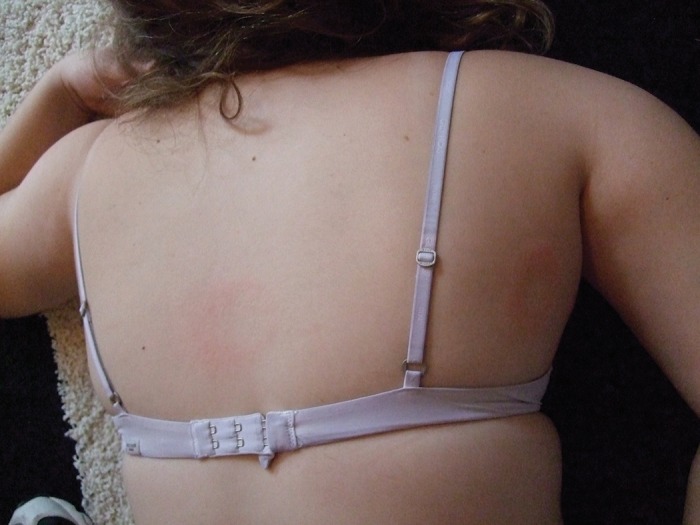
The “ball SITE (sports-induced targetoid erythema) sign” presenting as erythematous annular lesions surrounding normal-appearing skin at the sites of high velocity contact of a racquetball with the skin on the right upper flank and the upper central back of a 13-year-old female racquetball player. [Copyright: ©2015 Cohen.]
Figure 2 (A, B, and C).
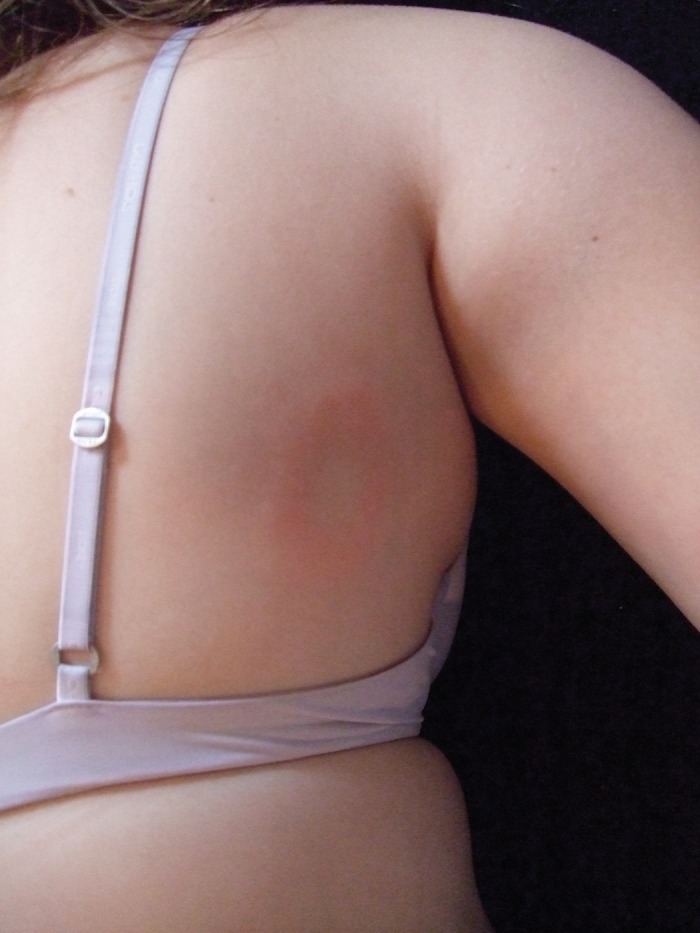
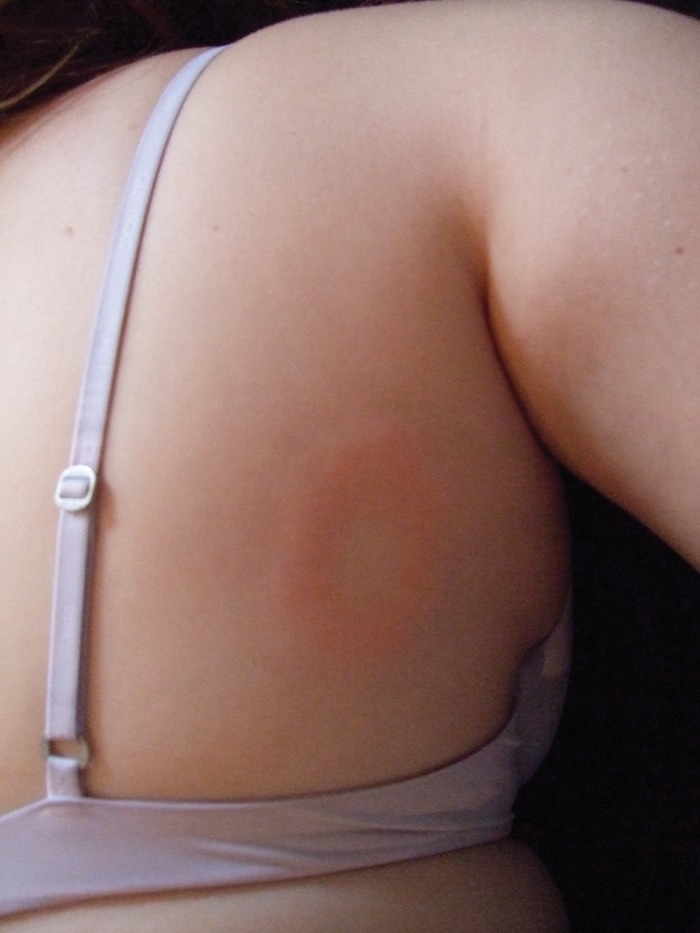
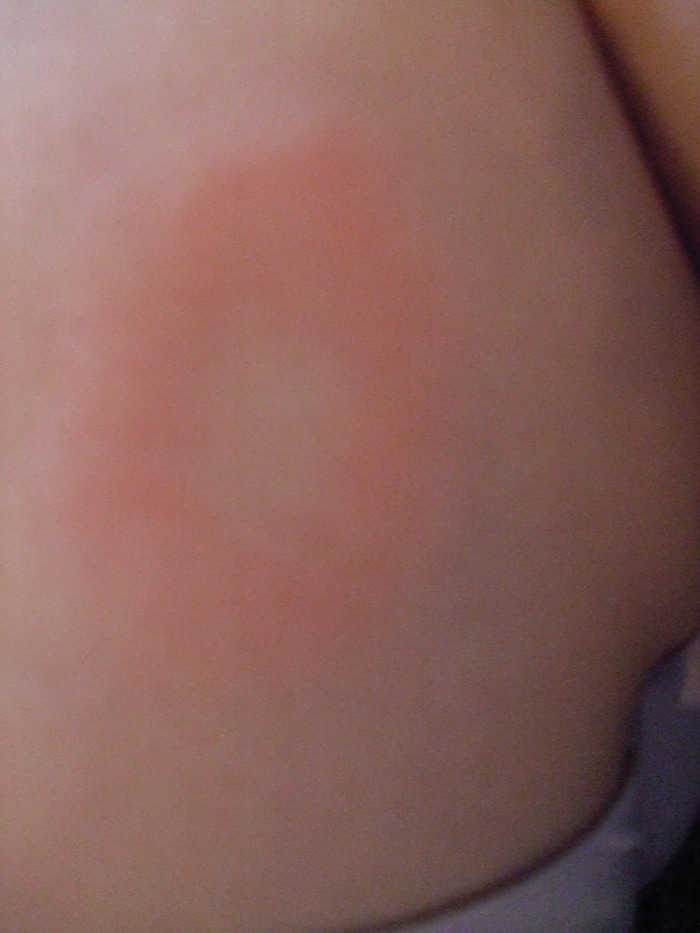
Distant (A) and closer (B and C) views of the right upper flank show a “racquetball associated targetoid erythema (RATE) sign” consisting of a central area of normal-appearing skin corresponding to the site of the racquetball contact with the skin and a broad surrounding raised annular red ring. [Copyright: ©2015 Cohen.]
Figure 3 (A and B).
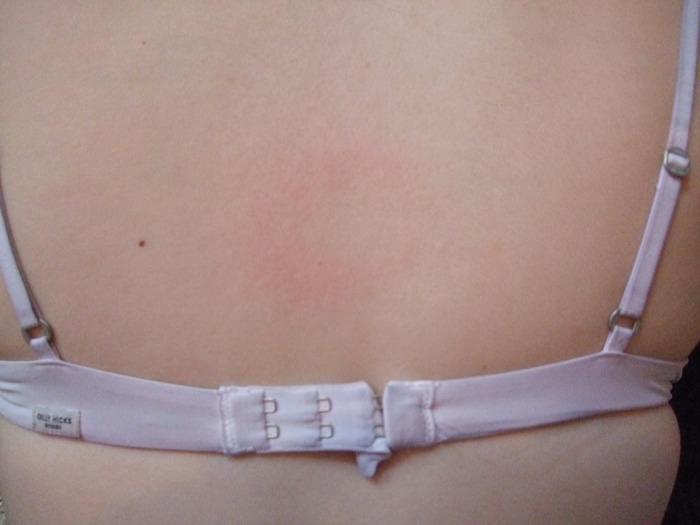
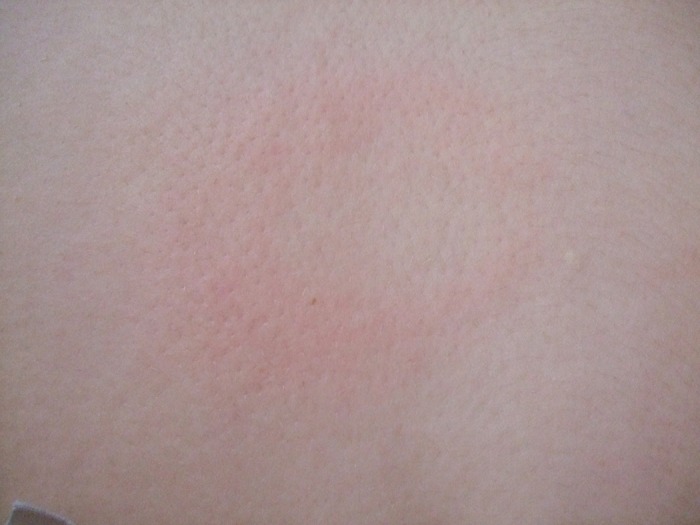
Distant (A) and closer (B) views of the upper central back targetoid erythema associated resulting from contact of a racquetball with the skin appearing as normal skin at the impact site surrounded by an annular zone of macular erythema. [Copyright: ©2015 Cohen.]
Discussion
A distinctive cutaneous lesion from high velocity ball-to-skin impact has only been observed, to date, in association with five sports: floorball, paintball, ping pong, racquetball, and squash [1–16]. Nomenclature, specific to each of the individual sports, has been proposed (Table 1) [1–16]. However, the reference to these lesions as “sports purpura” is not always accurate since only erythema—without the sequential development of purpura—may occur [2,9,16].
TABLE 1.
Sports-specific nomenclature of the cutaneous lesion resulting from the impact of a high velocity contact of the ball to the skin [a,b]
| Floorball [c] Floorball ecchymotic patches [1,2] Floorball purpura [current report] |
| Paintball Paintball purpura [5–7] Paint pellet erythema [d] [4] Paint pellet purpura [e] [3] |
| Ping pong Ping pong patches [f] [8] |
| Racquetball Annular erythematous (and occasionally purpuric) patches [g] [9] Annular lesion [8] RATE (racquetball-associated targetoid erythema) sign [current report] |
| Squash Annular erythematous (and occasionally purpuric) patches [h] [9] Annular lesion [8] TEAS (targetoid erythema associated with squash) sign [current report] |
The term “sports purpura” has been used by some authors to describe the observed clinical lesions. However, erythema may: (1) only develop, or (2) concurrently present with purpura, or (3) initially appear and be followed subsequently by purpura [11].
The “ball SITE (sports-induced targetoid erythema) sign” is a proposed new unifying terminology—regardless of the specific ball sport—to define the unique and pathognomonic cutaneous lesion resulting from high velocity impact contact of the ball to the skin.
Floorball is also referred to as either innebandy (in Sweden and Norway), salibandy (in Finland) and unihockey (in Germany and Switzerland); “bandy” refers to a team winter sport played on ice in which the skaters use sticks to hit a ball into the opposing team’s goal and “inne” and “sali” translates to “indoor”. The floorball ball is white, 72 mm in diameter, and 23 grams in weight and made of plastic; it is hollow and has 26 holes each of 11 mm in diameter. The fastest ball speed has been recorded at a velocity of 204 kilometers per hour (which is equivalent to 127 miles per hour) [1,2,10].
Impact-associated injuries from the floorball were recorded in 3% of 172 injuries (occurring in 4 of 133 injured women) among a study group of 374 female floorball players [16]. Ecchymotic patches of purpura occur at the cutaneous impact site of the ball in floorball players [1,2]. The patch is initially annular, confluent, and corresponds to the diameter of the holes in the ball; in some circumstances, the lesion enlarges and displays a Swiss cheese-like pattern with discrete white-round areas within the patch [1,2,10].
Rahbari and Nabai described “paint pellet erythema” in a 19-year-old man with “three nonpruritic, annular, erythematous lesions [on the upper back] . . . that developed after the patient was hit by several paint pellets two days earlier” [4].
Seigel et al described a “targetoid lesion” on both the arm and back of a 32-year-old woman that occurred at the “sites in which she was hit on bare flesh by paint bullets while enjoying a survival game outing two days previously”. The individual “irislike lesions had an ecchymotic margins surrounding a central clear zone and a ‘bullseye’superficial erosion” [3].
Scott and Scott observed that the lesions “are uniformly circular, 12 to 15 mm in diameter, with clear centers and an annular 3 mm border that is generally erythematous but may be purpuric”. They also included a figure of an “annular popliteal lesion from a racquet ball” [8].
Barazi and Adams, in a correspondence titled “sports purpura,” include an accompanying figure legend that describes a “large, erythematous, annular patch created by the impact of a racquet ball.” The authors comment, “initially, the lesions demonstrate an annular, urticarial plaque, but progress to exhibit purpura” and that “the purpura may take one week to resolve [9].
Subsequent to the high velocity impact of a squash ball with the skin there is a central ecchymosis surrounded by a white ring and then an erythematous targetoid zone [12,13]. In some patients, additional zones of white (normal-appearing skin) and purpura are observed [14]. Indeed, two brothers—Camaron and Morgan Pilley—decided to confirm the clinical consequence to a participant’s back following contact of a high velocity squash ball with the skin. Cameron, at a distance of 2 meters, served a squash ball directed toward his brother Morgan’s back; an ecchymosis-lined erosion resulted at the point of contact that was surrounded by a white ring (or normal appearing skin) and a broad annular target of erythema [15].
The initial description of this phenomenon—using alliteration to eloquently emphasize the extraordinary entity—was reported by Seigel et al in 1986 as “paint pellet purpura: a peril for pistol-packing paramilitary personnel” [3]; however, the initial lesions immediately after injury had not evaluated and may have shown targetoid erythema prior to the development of purpura. Additional reports regarding this form of dermatosis in paintball competitors were eventually published [4]. Subsequently, the terminology was modified and the “paint pellet” became known as the “paintball”; thereafter, several authors incorporated the new name of the dermatosis-causing object when describing similar lesions: paintball purpura [5–7].
Scott and Scott reported, “ping pong patches” on the thigh of a table tennis participant and mentioned that “similar annular, but larger, lesions may occur . . . by the balls used for racquetball and squash” [8]. Barazi and Adams provided an illustration of this pathognomonic targetoid erythematous pattern of injury in a racquetball player in a correspondence titled “sports purpura” [9–11]; however, similar to the girl in this report and the player described by Barazi and Adams, not all of the racquetball players developed purpura at the site of contact by ball with the skin. This unique dermatosis secondary to the high velocity impact of a squash ball with the skin has also been observed [12–15].
Impact-associated injuries also occur in floorball players [16]. In contrast to the concentric annular lesions that occur following high velocity contact of the ball and the skin in participants of paintball, ping pong, racquetball and squash, ecchymotic patches of purpura have been described at the cutaneous impact site of the ball in floorball players [1,2]. The patch initially corresponds to the diameter of the holes in the ball; the lesion may subsequently enlarge and display a Swiss cheese-like pattern with discrete white-round areas within the patch [1,2,10].
Targetoid erythema resulting from the impact of a high velocity ball with the skin is a sports-related injury that has been observed in participants of paintball, ping pong, racquetball, and squash; subsequently, in some of the individuals, purpura may also develop. This distinctive lesion has not been noted in sports associated with either smaller balls (such as hand ball, perhaps because they do not travel at as fast a velocity) or larger balls (such as tennis balls, since they may not be altered on impact with the skin or because they may result in damage not only to the skin but also to the subcutaneous structures including fat, muscle and possibly bone). In contrast to the several names—related to each individual sport—that have previously been associated with this phenomenon, a unifying term, the “ball SITE (sports-induced targetoid erythema) sign,” is introduced to designate this unique cutaneous pattern of injury.
There are multiple components that contribute to the mechanism of injury. These include not only the velocity at which the ball is traveling, but also other characteristics of the ball such as the composition, the diameter, and the weight (Table 2) [6–8,14,17–24]. Scott and Scott have hypothesized that the ping pong ball—traveling at a high velocity—becomes indented after it strikes the skin. Once the contour of the ball has changed and maximum indentation has occurred, a targetoid lesion of erythema (or purpura) results when the circular edge of the indented ball impinges, with considerable pressure, against the skin [8].
TABLE 2.
Characteristics of balls that can produce targetoid erythema following high velocity contact impact of the ball to the skin [a,b]
| Ball | Paintball | Ping pong ball | Racquetball | Squash ball |
|---|---|---|---|---|
| Composition | Gelatin [c] | Plastic [d] | Rubber | Rubber [e] |
| Weight (gm) | 3.2–3.3 | 2.5–2.7 | 56.7–58.5 | 23–25 |
| Diameter (mm) | 17 | 38–40 | 57 | 39.5–40.5 |
| Speed (kph) [f] | 307–330 | 161 | 124–241 | >241 |
| References | 6,7,17,18 | 6,8,19 | 14,20–22 | 14,23,24 |
Abbreviations: gm, grams; kph, kilometers per hour; mm, millimeters; mph, miles per hour
The paintball is smaller (more than half the diameter) and heavier (about 25%) than a ping pong ball [6–8,18,19]. In contrast, the squash ball is the essentially the same diameter as a ping pong ball, but ten times heavier [8,19,24]. And, the racquetball is nearly 1½ times larger in diameter and more than twenty times heavier than a ping pong ball [8,10,19,20]. All of these balls potentially travel 1½ to twice as fast as a ping pong ball [6–8,14,17–24].
Spherical gelatin capsules containing primarily polyethylene glycol, other non-toxic and water-soluble substances and dye.
Air filled, celluloid or similar plastics material.
The squash ball consists of two pieces of rubber compound, glued together to form a hollow sphere and buffed to a matte finish.
The speed of the ball can also be calculated in miles per hour: paintball = 191–205, ping pong ball = 100, racquetball = 77–150, and squash ball = >150. Racquetball speeds have ranged from: (1) 124 kph (77 mph) to 145 kph (90 mph) during matches with women and (2) 209 kph (130 mph) to 241 kph (150 mph) during matches with men; the fastest recorded speed is 307 kph (191 mph) [14,20–22]. The fastest recorded squash ball speed is 204 kph (127 mph) [14,23,24].
However, the pathogenesis of injury resulting in targetoid erythema from skin contact with a high velocity paint-ball, racquet ball or squash ball may be different than that from a ping pong ball. It is possible that the faster, larger, and heavier paintball and racquetball produce centrally located, impact-associated, blanching with a peripheral zone of dermal changes characterized morphologically by macular or indurated erythema; in some circumstances, impact-associated vessel damage and extravasated erythrocytes in skin immediately adjacent to the contact site of the ball may subsequently result in clinical purpura. The point-of-contact injury from the faster and heavier squash ball is of sufficient impact to cause disruption of vessels with subsequent ecchymosis or destruction of epidermis and superficial dermis with resultant erosion or both; the adjacent tissue damage results not only in zones of circumferential blanching and erythema, but also—in some individuals—additional annular rings of blanching and purpura.
The clinical differential diagnosis of the ball SITE sign includes annular or targetoid lesion with either flat or raised erythematous borders (Table 3) [4–7,9]. The lesion may appear purpuric a few days after the causative event. However, a focused medical history readily suggests the correct diagnosis of a cutaneous injury secondary to contact of the skin with either a paint ball, ping pong ball, racquet ball or squash ball.
TABLE 3.
Clinical differential diagnosis of the ball SITE sign [a]
| Cupping (application of suction cups) |
| Dermatitis medicamentosa |
| Erythema annulare centrifugum |
| Erythema chronicum migrans |
| Erythema multiforme |
| Factitial dermatitis |
| Fixed drug eruption |
| Granuloma annulare |
| Gyrate erythemas |
| Insect bite reaction |
| Majocchi’s disease (purpura annularis telangiectoides) |
| Physical abuse |
| Tinea corporis |
| Urticaria |
The “ball SITE sign,” is the “ball sports-induced targetoid erythema sign.”
Symptomatic treatment for localized symptoms may be necessary. The ball SITE sign is accompanied by acute pain at the site of contact of the ball to the skin. Macular or edematous erythema appears shortly after the traumatic event. Impact-associated contusion to the underlying tissue may result in the affected area remaining mildly tender to palpation for the next few days; acetaminophen or nonsteroidal anti-inflammatory drugs may reduce the pain. The erythema (and occasional associated purpura) resolves spontaneously in approximately seven to 14 days.
Conclusion
A distinctive cutaneous lesion occurs following high velocity ball-to-skin impact in participants of paintball, ping pong, racquetball and squash. Targetoid erythema presents as an annular red ring surrounding a central normal-appearing area of skin at the site of contact of the paintball, ping pong ball or racquetball. In some of these individuals purpura may concurrently or subsequently develop; purpura alone may also occur following skin contact with a paintball. Impact injury of a squash ball with the skin is associated with a central area of ecchymosis surrounded by a concentric white ring and an erythematous targetoid area. Descriptive terms associated with each sport, often incorporating either alliteration or acronyms, have previously been used to name the lesion: paintball purpura, ping pong patches, racquetball-associated targetoid erythema (RATE) sign, and targetoid erythema associated with squash (TEAS) sign. The “ball SITE (sports-induced targetoid erythema) sign,” is introduced as a unifying term to designate this unique cutaneous pattern of injury in athletes participating in sports in which high velocity impact of the ball with the skin may occur.
Footnotes
Funding: None.
Competing interests: The authors have no conflicts of interest to disclose.
All authors have contributed significantly to this publication.
References
- 1.Kluger N. Sports purpura from football, indoor climbing, and archery [case letter] Cutis. 2015;95:E3–E4. [PMID = in progress] [PubMed] [Google Scholar]
- 2.Kluger N. Sports purpura. Presse Med. 2012;41:899–906. doi: 10.1016/j.lpm.2012.01.031. [DOI] [PubMed] [Google Scholar]
- 3.Siegel DM, Goldberg LH, Altman AR, Kalter DC. Paint pellet purpura: a peril for pistol-packing paramilitary personnel [letter] JAMA. 1986;255:3367. [PubMed] [Google Scholar]
- 4.Rahbari H, Nabai H. Paint pellet erythema [letter] Pediatr Dermatol. 1996;13:174–5. doi: 10.1111/j.1525-1470.1996.tb01431.x. [DOI] [PubMed] [Google Scholar]
- 5.Metelitsa A, Barankin B, Lin AN. Diagnosis of sports-related dermatoses. Int J Dermatol. 2004;43:113–9. doi: 10.1111/j.1365-4632.2004.02101.x. [DOI] [PubMed] [Google Scholar]
- 6.Levsky ME, Crowe M. What is your diagnosis? Paintball purpura. Cutis. 2005;75:148. [PubMed] [Google Scholar]
- 7.Aboutalebi S, Stetson CL. Paintball purpura [letter] J Am Acad Dermatol. 2005;53:901–902. doi: 10.1016/j.jaad.2005.05.019. [DOI] [PubMed] [Google Scholar]
- 8.Scott MJ, Jr, Scott MJ., 3rd Ping pong patches. Cutis. 1989;43:363–4. [PubMed] [Google Scholar]
- 9.Barazi H, Adams BB. Sports purpura. Int J Dermatol. 2006;45:1443. doi: 10.1111/j.1365-4632.2006.03135.x. [DOI] [PubMed] [Google Scholar]
- 10.Australian Floorball Association What’s floorball? Posted July 6, 2009 http://www.floorball.org.au/index.php?option=com_content&view=category&id=3&layout=blog<emid=5 Accessed May 9, 2015.
- 11.Aguayo-Leiva I, Vano-Galvan S, Arrazola JM. A purpuric rash. Aust Fam Physician. 2009;38:889–90. [PubMed] [Google Scholar]
- 12.Powell R. Howick squash: hit by a squash ball. Posted Thursday 28 April 2011 http://howicksquash.blogspot.com/2011/04/hitby-squash-ball.html accessed May 9, 2015.
- 13.Reed L. My worse sports injury—ABC WA—Australian Broadcasting Corrporation (ABC) Saturday breakfast with Pat Hagan. Posted June 17, 2010 http://blogs.abc.net.au/wa/2010/06/my-worse-sports-injury.html?site=kimberley&program=kimberley_saturday_breakfast Accessed May 9, 2015.
- 14.Nair D. Squash or tennis, which one is the harder sport? Racquet Social. http://racquetsocial.com/squash-or-tennis-which-one-is-the-harder-sport/ Accessed May 9, 2015.
- 15.Bednall J. Serve on sibling an internet hit. The Advertiser. Posted November 6, 2011 http://www.adelaidenow.com.au/sport/serve-on-sibling-an-internet-hit/story-e6frecj3-12226186684669 Accessed May 9, 2015.
- 16.Pasanen K, Parkkari J, Kannus P, et al. Injury risk in female football: a prospective one-season follow-up. Scand J Med Sci Sports. 2008;18:49–54. doi: 10.1111/j.1600-0838.2007.00640.x. [DOI] [PubMed] [Google Scholar]
- 17.Conn JM, Annest JL, Gilchrist J, Ryan GW. Injuries from paintball game related activities in the United States, 1997–2001. Injury Prevention. 2004;10:139–43. doi: 10.1136/ip.2003.004101. [DOI] [PMC free article] [PubMed] [Google Scholar]
- 18.Woodward A. How paintball is made-material, making, history, used, product, industry, machine, history, raw materials, the manufacturing process of paintball, quality control, byproducts/waste. http://www.madehow.com/Volume-6/Paintball.html Accessed May 9, 2015.
- 19.The ball (version for 40mm balls) technical leaflet T3. The International Table Tennis Federation. Posted May, 2011 http://www.ittf.com/stories/pictures/T3_Ball40mm_BoD2011.pdf Accessed May 9, 2015.
- 20.What are the dimensions of a racquetball ball? http://www.answers.com/Q/What_are_the_dimensions_of_a_racquetball_ball Accessed May 9, 2015.
- 21.Cox N. Racquetball speed. Squash & Racquetball. Posted April 17, 2011 http://en.allexperts.com/q/Squash-Racquetball-1548/2008/4/f/Racquetball-speed.htm accessed May 9, 2015.
- 22.1996–97 AARA Official rules of racquetball. The Garden State Racquetball Association Official AARA Racquetball Rules. http://www.math.rutgers.edu/~sontag/racquetball-rules.html Accessed May 9, 2015.
- 23.Horton L. Big-banging Aussie clocks up 176 mph raising the bar by . . . ONE. Squash Mad. Posted May 9, 2014 http:/squashmad.com/breaking-news/cameroin-pilley-breaks-his-own-/world-speed-record/ Accessed May 9, 2015.
- 24.Balls-the name of the game. Squash Player. http://www.squash-player.co.uk/squash_balls.htm Accessed May 9, 2015.


